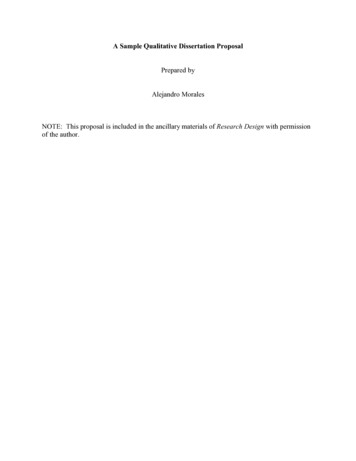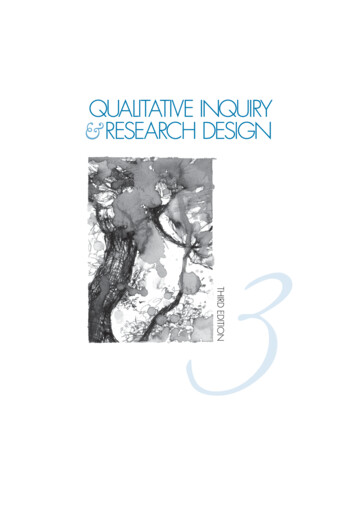
Transcription
A Sample Qualitative Dissertation ProposalPrepared byAlejandro MoralesNOTE: This proposal is included in the ancillary materials of Research Design with permissionof the author.
LANGUAGE BROKERING IN MEXICAN IMMIGRANT FAMILIES LIVING INTHE MIDWEST: A MULTIPLE CASE STUDYbyAlejandro MoralesA DISSERTATION PROPOSALPresented to the Faculty ofThe Graduate College at the University of NebraskaIn Partial Fulfillment of RequirementsFor the Degree of Doctor of PhilosophyMajor: Interdepartmental Area of Psychological Studies in Education(Counseling Psychology)Under the Supervision of Professor Oksana F. YakushkoLincoln, NebraskaApril, 2006
2Chapter 1IntroductionIt is estimated that approxmately 33.1 million of immigrants (documented andundocumented) live in the United States (Camarota, 2002). Like other groups living in the U.S.,immigrants are a heterogeneous group and their reasons for coming to this country vary (Felicov,1998; Santiago-Rivera, Arredondo, Gallardo-Cooper, 2002). For example, there is a cleardistinction between a person who immigrates voluntarily and refugees who involuntarily leavetheir countries of origin due to fear of persecution. Refugees are individuals who have to fleetheir countries because of persecution and fear of being killed. A great number of theseindividuals have been tortured or have seen friends or relatives being tortured (AmnestyInternational, 2002). Given that a significant number of refugees are victims of torture orwitnesses of torture, their adaptation to their new environment is more challenging than otherimmigrants (Suarez-Orozco & Suarez-Orozco, 2001).There are also within-group differences among immigrants who share the same culture.For example, there are clear distinctions within the Latino immigrant group as not allundocumented individuals who cross the border between Mexico and the U.S are of Mexicandescent (Felicov, 1998; Santiago-Rivera, Arredondo, & Gallardo-Cooper, 2002). The scholarshipon immigration highlights an array of reasons why individuals from foreign countries come toindustrialized countries such as the U.S. (Suarez-Orozco & Suarez-Orozco, 2001). We observethat immigrants from Mexico often come to the U.S. because they can no longer afford tosupport their families or because working in agriculture is no longer a job that producessufficient income (Santiago-Rivera, Arredondo, & Gallardo-Cooper, 2002). These are a few ofthe reasons why other individuals from Latin-America come to the U.S. Conversely, there are a
3number of individuals who immigrate to the U.S. due to fear of being persecuted. A number ofthem come from countries in Central and South America. Many of them, unaware of the asylumprocess or fearing that they will not be granted asylum, decide to immigrate to Mexico and thento the U.S with no type of legal documentation (Santiago-Rivera, Arredondo, & GallardoCooper, 2002).There are various causes as to why people from other countries immigrate to prosperouscountries such as the U.S. Suarez-Orozco & Suarez-Orozco (2001) describe an array of reasonsproposed by social and behavioral scientists to explain why people leave their countries of originand immigrate to industrious societies. The immigrant population in the U.S. continuesincreasing at a non-stop rate. For example, Latinos have become the largest ethnic minority inthe U.S. with Mexicans being the largest subgroup (U.S. Census Bureau, 2005). Individuals ofLatin-American descent are often subsumed under a single ethnic category, thus, perpetuating afallacy that Latinos are a homogenous group. Fortunately, research with the Latino populationdemonstrates that this group is, in fact, heterogeneous (Padilla, 1995).Part of the heterogeneity of Latinos is related to the ethnic category this group usuallyuses to identify themselves. Scholars, politicians, and mainstream culture may refer to them asLatinos, Hispanics, Spanish Speaking people, and so on. Latinos can vary in their phenotype;they may look black, brown, Asian or white. This diversity is due to the influences ofcolonization of the American continent, where indigenous groups blended with Africans whowere forced to come as slaves and Europeans who came to conquer the American continent(Felicov, 1998).There is a continuous debate about what Latinos should be called. The terms Latino (formales) and Latina (for females), for example, refer to men and women whose origin is from
4Latin America. This term is preferred because it has no connection with Spaniards (Comas-Diaz,2001) and reaffirms the indigenous background of Latinos (Felicov, 1998). Felicov also arguesthat although individuals from Latin America do not speak Latin, many speak Spanish, which isderived from Latin.Hispanic is another common category use to identify individuals of Latin-Americandescent. This term was created in the 1970s by the U.S. census to group individuals who spokeSpanish (Comas-Diaz, 2001). The term is typically used among those individuals who identifymore with their European (i.e., Spaniard) background. Lastly, Spanish people is the othercategory used very deliberately in the U.S. to describe Latinos. Comas-Diaz (2001) providesmore discussion on how this term is utilized to portray individuals who are Spanish-speaking.The use of different terms highlights not only the debate about the choice of words to nameLatinos. This debate also recognizes the diversity of Latinos around the world and within theU.S. as well as different histories faced by this group.When immigrants arrive in the U.S. they are expected to adapt to their new environment,learn a new language, and adopt values, beliefs, and customs of the new culture. The process ofacculturation begins as soon as immigrants and their families come in contact with U.S. culture.For immigrant families living in the U.S. this adaptation process can be stressful andoverwhelming (Baptise, 1987; Rumbaut, 1994). Immigrants often rely on their children or theirextended family to function socially in American society.Once children of immigrant families become familiar with the English language, theyoften serve as translators and interpreters for their non-fluent parents and family members. Thesechildren, known in the social and behavioral sciences as language brokers, are repeatedly askedand sometimes expected to assist their parents in very complex adult level situations that may
5surpass their cognitive abilities (McQuillan & Tse, 1995; Tse 1996a; Tse, 1995a; Tse, 1995b;Valenzuela, 1999).The literature in the area of language brokering is scarce and fairly recent. Morales andHanson (2005) reported in an integrative review of the literature that fifty-seven percent of theavailable research is published in peer-reviewed journals, seventeen percent is published in bookchapters, and twenty-six percent are conference papers, dissertations, or ERIC documents.Despite this common phenomenon in immigrant families, it was not until the mid 1990s whenstudies about language brokers and/or brokering were introduced in social and behavioralsciences’ literature. Early studies investigated the prevalence of language brokering amongchildren of immigrant families. Instruments to measure this construct were also developed duringthis time frame (Buriel, Perez, DeMent, Chavez, & Moran, 1998; Tse, 1996a). Morales andHanson (2005) also highlight that little to no attention has been given to how having a child as aninterpreter and/or translator impacts the immigrant family.In the social and behavioral science literature, language brokering is defined as the actionof translating and interpreting that children/adolescents in immigrant families’ perform for theirparents, family members, teachers, neighbors, and other adults (McQuillan & Tse, 1995).Furthermore, language brokers not only translate and interpret, but they also serve as culturalbrokers and mediators in a variety of situations for their parents (DeMent & Buriel, 1999; Tse,1996a).It is important to note here the distinction between translating and interpreting. Althoughtranslating and interpreting are often considered to be synonymous or identical constructs, theyrefer to quite different actions. Translating is perhaps best associated with written work, wherethe translator is believed to possess exceptional understanding of multiple languages, thus,
6having the ability and skill to translate documents, materials, and the like. Interpretation, on theother hand, is best associated with verbal communication, where the interpreter is believed topossess exceptional understanding of potentially nuanced and circumscribed “meanings” thatmay be conveyed in ordinary social interactions (Westermeyer, 1989). Hence, children who areconsidered language brokers engage in both translating (e.g. bank statements) and interpreting(e.g., doctor’s appointment).The scholarship in language brokering is fairly recent in the social and behavioral scienceliterature, even though having children translate and interpret is a common role that children ofimmigrant families undertake when they arrive to the U.S. Early studies in language brokeringattempted to describe the type of activities child brokers engaged in as well as their feelingsabout playing such roles. For example, in a study by Tse (1995b) half of the Latino child brokersreported that translating and interpreting helps children learn more about their first and secondlanguage. The results of this investigation demonstrate that language brokering helps childrenexpand their vocabularies and develop a bicultural identity. Furthermore, there are those whobelieve that language brokering is a form of giftedness (e.g., Valdez, 2003).Others, such as Weisskirch and Alva-Torre (2002), indicate that children who serve aslanguage brokers report that such experiences are neither helpful nor enjoyable. In their study,children reported that the more they felt uncomfortable translating and interepreting.Furthermore, Weisskirch and Alva-Torre found a positive relationship between acculturativestress and brokering among boys. The results of their investigation suggest thatchildren,especially boys, who translate and interpret could be more prone to acculturative stresswhich could impair their adjustment to the U.S.
7Although both of these arguments are legitimate and have important empirical support,more research is needed to help understand the implications of children who serve as translatorsand interpreters. The available literature in language brokering neglects to combine theperspectives of parents and children. Thus, the purpose of this multiple qualitative case study isto understand the role of language brokering in Mexican immigrant families living in theMidwest.Rationale for StudyThis qualitative multiple case study is important and needed for several reasons. First, agap exists in the language brokering literature where the perspectives of the parents and brokersare not integrated to understand the implications of language brokering in the immigrant family.The available literature has only focused on the experience of language brokers. The majority ofthe scholarship has also been mainly quantitative. Thus, the second goal of this study is to focuson qualitative findings in order to gain an in-depth understanding of how language brokering isexperienced by Mexican immigrant parents and their children. Third, language brokering is acommon phenomenon in immigrant families. Recent changes in U.S. demographics highlight theincrease of Mexican families as they are the largest subgroup within the Latino ethnic groupliving in the U.S. Fourth, this study will add new knowledge to this neglected area, but it alsoprovide information to social scientists, health care providers, mental health professionals,educators, and policy makers to better understand the needs of Mexican immigrant families withchildren who translate and/or interpret for their families. Fifth, the language brokering studiesconducted have used samples where large numbers of Latinos reside. This study will beconducted in a large Midwestern city where Latinos are increasing in number. Finally, this study
8will provide information for future researchers who wish to study language brokering withimmigrant families other than Mexicans.Rationale for Qualitative MethodsThe purpose of qualitative research is to understand and explain participant meaning(Morrow & Smith, 2000). More specifically, Creswell (1998) defines qualitative research as,an inquiry process of understanding based on distinct methodological traditions ofinquiry that explore a social or human problem. The researcher builds a complex, holisticpicture, analyzes words, reports detailed views of informants, and conducts the study in anatural setting (p.15). Thus, using a qualitative methodology allowed the researcher to study thephenomenon of language brokering in its naturalistic setting. Qualitative research has been anideal tool in multicultural counseling research. Morrow, Rakhsha & Castaneda (2001, p.582-583)provide an array of reasons for using qualitative research to study multicultural issues. Forexample:1. It includes context as an essential component of the research.2. It addresses the researcher’s process of self-awareness and self-reflection.3. It is uniquely able to capture the meanings made by participants of their experiences.4. Scholars in the field of multicultural counseling and psychology have called for expandedmethodological possibilities to address questions that cannot be answered usingtraditional methods.5. Its methods provide the opportunity for voices that were previously silenced to be heardand lives that were marginalized to be brought to the center.Statement of the Problem
9Language brokering is a common practice in immigrant families living in the U.S. Theavailable scholarship in this understudied area has mainly focused on the experience of childbrokers. This scholarship also suggests that the primary users of language brokers are parents,yet no studies have included how language brokering affects the immigrant family when theparents’ and broker’s perspectives are incorporated. Given the recent changes in demographics,Mexican immigrant families in the U.S. are increasing at a non-stop rate. Hence, it is necessaryto conduct a study that explores the phenomenon of language brokering in this growing group.Research QuestionsThe central research question that this study aimed to answer is, what is the role oflanguage brokering in Mexican immigrant families living in the Midwest. This study will alsoaddress the following research sub-questions:1. How do Mexican immigrant families view language brokering?2. What are qualities and/or characteristics of language brokers?3. What are the family dynamics when parents use their son/daughter fortranslating/interpreting?Outline of DissertationThis dissertation will be divided into six chapters and an appendix section. The firstchapter will provide a brief introduction about the area of language brokering, the rationale forthe study, the rationale for using qualitative research methods, statement of the problem, and theresearch questions. Chapter two will present a comprehensive review of the literature. The thirdchapter will describe the research methods including how cases will be selected, the forms ofdata collection, how data will be analyzed, the validation strategies use to increase the validityand reliability of the study, potential ethical issues, and the role and background of the
10researcher. Chapter four will present and highlight the results of the case-by-case analysis. In thischapter, each case will be described in great detail along with the themes that emerged from eachof the cases. Themes will be presented accompanied with quotes. In chapter five, the results ofthe cross-analyses will be presented accompanied with thick and rich quotes representingdifferent perspectives. The last chapter will discuss the results of the study, the implications fortheory development, practice, public policy, future research, the strengths and limitations of thestudy, a conclusion, a section on lessons learned, as well as the references used in all the chaptersof this dissertation. There will also be an appendix section that include copies of the internalreview board approval from UNL, the informed consent forms in English and Spanish, interviewprotocols in English and Spanish, the demographic questionnaire in English and Spanish, theobservation protocol, and the documents that families provided and were used in the nonparticipant observation.
11Chapter 2Review of the LiteratureThe American Psychological Association (APA) has recently started to pay attention tothe importance of providing empirical evidence about the psychological well being of immigrantgroups (APA, 2005). Thus, APA released a resolution on immigrant children, youth and familiesthat,advocates for the development of a scientific database concerning the adaptation,development, education, health and mental health, as well as the social impact andcontributions, of immigrant and refugee populations (p.1).This chapter is divided into four sections. The first section describes the phenomenon ofimmigration. This section highlights (1) debate between social and behavioral scientistsregarding the causes of immigration, (2) a theoretical model describing the stages ofimmigration, (3) statistics about immigrants living in the United States, and (4) distinctionsbetween immigrants and refugees, two unique groups of individuals. The second section of thischapter focuses on the acculturation process immigrants experience as the result of their contactwith the U.S. culture, as well as the outcomes of experiencing acculturation in the U.S. The thirdsection emphasizes one subgroup of immigrants, Latinos, and elaborates on a demographicprofile of this group, as well as describes Latino family values and family dynamics. Finally, thefourth section presents the available literature in the area of language brokering within immigrantfamilies highlighting the limited available research in this topic and the need for continuedscholarship in this area of study.Immigration
12Immigration has been a salient phenomenon in the history of mankind. For centuries,men and women have migrated from place to place for various reasons (Suarez-Orozco &Suarez-Orozco, 2001). Suarez-Orozco and Suarez-Orozco highlight that economists believe thatindividuals immigrate to more prosperous countries because of better employment opportunitiesand higher wages. Sociologists argue that individuals immigrate because of the networks theyhave developed with relatives, friends, or friends of friends in other countries. Other reasons thatexplain immigration are those proposed by anthropologists who indicate that people immigratedue to changes in cultural models of desirable standards of living. Finally, there are otherscholars who consider immigration a rite of passage. In some countries, especially in ruralcommunities, men and women who have reached a certain age are expected to immigrate tocountries such as the U.S. (Suarez-Orozco & Suarez-Orozco, 2001).When individuals decide to immigrate, their subsequent relocation may follow apatterned process. Sluzki (1979) has proposed that the process of immigration can be viewedfrom a multi-stage perspective. These stages include (a) preparatory (b) the act of immigration(c) period of overcompensation (d) decompensation or crisis, and (e) period of transgenerationalimpact. During the preparatory stage, the family starts planning, making decisions, and takingtime to say goodbye to friends and relatives. The action of immigration stage, according toSluzki is experienced differently by families based on their access to legal documentation oreconomic resources. Thus, the family that comes from low social economic status and has nolegal documentation can experience more challenges coming to the new country. Theovercompensation stage is characterized by strong desires to preserve cultural traditions andvalues from their country of origin. Maintaining these traditions and values allows the family todevelop a certain sense of stability in the family. Sluzki indicates that this stage may be a
13reaction toward the changes in the family’s surroundings and culture. In the decompensation orcrisis stage, the family usually experiences a conflict often associated with acculturation and/orgender roles. Finally, in the period of transgenerational impact, the family continuesexperiencing changes in their adaptation to the new country as well as changes in values andinteractions between generations. Sluzki considers the last two stages of the immigrationexperience model as a time for change.Historically, men (e.g., fathers or male-heads of the household) were the first member ofa family to immigrate (Hondagneu-Sotelo, 1992). Fathers immigrate to other countries becausethey may no longer provide for the basic needs of their families (Suarez-Orozco & SuarezOrozco, 2001). More recently, entire families are immigrating to industrialized countries such asthe U.S. in hope of a better future. Suarez-Orozco & Suarez-Orozco (2001) highlight that everyyear 250,000 to 500,000 undocumented immigrants enter the U.S.It is important to distinguish between voluntary and involuntary migration. Refugees areindividuals who flee their countries because of persecution and fear of being killed. Many ofthese individuals have been tortured or have seen friends or relatives being tortured (AmnestyInternational, 2002). Given that a significant number of refugees are victims of torture orwitnesses of torture, their adaptation to their new environment is more challenging thanimmigrants (Suarez-Orozco & Suarez-Orozco, 2001).Immigration has become a topic of discussion in social and behavioral research, publicpolicy, and in the area of politics. More and more immigrants are coming to the U.S., causing aunique change in demographics. Immigrants experience psychological and physiological changeswhen they relocate, facing unique circumstances when they arrive to a foreign culture such as the
14U.S. Adapting or acculturating to a new culture such as the U.S. could be quite difficult for someimmigrant groups.AcculturationWhen immigrant families arrive in the U.S., they are expected to adapt to their newenvironment, learn a new language, and adopt values, beliefs and customs of the new culture.The process of acculturation begins as soon as immigrants and their families come in contactwith the dominant culture. Social and behavioral scientists have studied the phenomenon ofacculturation within immigrant communities. These scholars view acculturation as consisting ofsocial and psychological interactions as a result of the contact between individuals of differentcultures (Berry, 1997; Ryder, Alden & Paulhus, 2000). These interactions occur in a variety ofdomains including attitudes, behaviors, and sense of cultural identity (Cuellar, Arnold, &Maldonado, 1995; Ryder et al., 2000). More recently, acculturation has been studied at theindividual level and associated with ethnic identity development (Phinney, 2002).Acculturation ModelsModels of acculturation have been proposed challenging researchers to think morecritically about this area of study. The early model is the unidirectional or unilinear model ofacculturation proposed by Parks and Miller (1921). According to these scholars, acculturation isunipolar where the individual moves from the traditional life style to a more assimilated style ofliving. More specifically, in the context of the immigration, the family starts adopting values andcustoms of the mainstream culture and slowly begins leaving behind their own values andcustoms.The second model is the bidirectional or bidimensional model of acculturation (Berry,Trimble & Olmedo, 1986). The bidirectional model is more comprehensive and more widely
15accepted among social scientists (e.g., Flannery, Reise, & Yu, 2001). This model focuses on therelation of two constructs along the two axes, identification with home culture and identificationwith host culture. The model is comprised of four acculturation styles integration/bicultural(identification with both cultures), assimilation/Americanized (identification with host culture),alienation/marginalization (no identification), separation/traditional (identification with homeculture). These theoretical models demonstrate that the scholarship on acculturation has soughtto better understand the experiences of immigrant groups in order to understand how individuals’cultural background plays a role in their adaptation.Acculturative StressThe process of acculturation may be quite difficult for some immigrant groups. Berry,Kim, Mindle, and Mok (1987) use the term acculturative stress to explain the feelings ofimmigrants who come in contact with a new culture. Berry et al., define it as,the kind of stress, that in which the stressors are identified as having their source in theprocess of acculturating; in addition, there is often a particular set of stress behaviorswhich occurs during acculturation, such as lowered mental health status (specificallyconfusion, anxiety, depression), feelings of marginality and alienation, heightenedpsychosomatic symptom level, and identity confusion (p. 492).Berry, Kim, Mindle and Monk’s acculturative stress model suggests that immigrantsexperience acculturative stress differently. Their model explains that acculturative stress isassociated with a number of stressors that are linked to the acculturation experience. Forexample, if an individual’s acculturation experience required a great deal of sacrifice andinvolvement, then the individual is likely to experience a number of stressors, thus causing theindividual to experience high levels of acculturative stress. Berry and colleagues describe a
16variety of factors that moderate the relationship between acculturation and stress. These factorsinclude the type of acculturating group, modes of acculturation, and demographic and socialcharacteristics of the individual as well as his or her psychological characteristics.Acculturation and Mental HealthAcculturative stress, if experienced in high levels, may have negative consequences onthe mental health of immigrants. Studies have reported that less acculturated individuals are lesslikely to experience mental health problems than their more acculturated counterparts. Forexample, studies conducted with Mexican immigrants and Mexican-Americans have reportedthat Mexican immigrants have better mental health profiles than Mexican-Americans (Escobar,Karno, Burnam, Hough, & Golding, 1988; Escobar, Hoyos-Nervi, & Gara, 2000).Other scholarship indicates that maintaining a bicultural identity has positiveconsequences to mental health and overall psychological well-being. Miranda and Umhoefer(1998) conceptualize biculturalism as being in the “intermediate level of acculturation” (p. 159).Being at the intermediate level may be considered as processing a balance between one’s culturalvalues and those of the host culture. In their research with Latinos, Miranda and Umhoeferreported that those individuals who were considered bicultural had better mental health wellbeing.The area of acculturation has provided vital information about the adaptation of variousimmigrant groups living in the U.S. Within all these different immigrant groups, the number ofLatinos has increased dramatically in the past ten years and are now the largest minority in theU.S.The Latino Family
17Recent census data indicates that Latinos are the largest ethnic minority in the U.S. withMexicans being the largest subgroup (U.S. Census Bureau, 2002). As Latinos continueincreasing in numbers, so do their needs. Latinos are still one of the most underserved groups inthe U.S in respect to health care and access to mental health services (Vega & Alegria, 2001).Individuals of Latin-American descent are often subsumed under a single ethnic category,perpetuating a fallacy that Latinos are a homogenous group. Thus, the research conducted withthe Latino population demonstrates that this group is, in fact, heterogeneous (Padilla, 1995).Latinos in the United States: A Demographic ProfileThe U.S. Census Bureau (2005) indicates that there are 4.13 million Latinos living in theU.S., from this, 66.9 % of them are of Mexican descent. Latinos are the largest ethnic minoritygroup in the U.S. and comprises 13.3% of the U.S. population. The U.S. census shows thatLatinos contain the largest proportion of people under the age of 18 when compared to theirWhite counterparts.Several unique features distinguish Latinos from other ethnic groups. Latino familyhouseholds are more likely than White family households to be maintained by a female without aspouse, with Puerto Ricans having the largest proportion of households maintained by a female.In terms of education, Latinos are at disadvantage. Among Latinos, Mexicans 25 years and olderhave the lowest proportion of people with a high school diploma, a bachelor’s degree or more. Interms of employment, Latinos are more likely to be unemployed than Whites. Among employedLatinos, the most common occupations are service workers, precision production, craft, repair,and transportation. Latinos are more likely to be living in poverty than Whites. Over one quarterof Latino children under the age of 18 live in poverty (U.S. Census Bureau, 2002).Latino Family Dynamics
18The Latino family also shows heterogeneous compositions because not all Latinofamilies are composed of two parent households. Santiago-Rivera et al. (2003), explain thatamong Latinos, the mother usually heads the single-parent family. Latino single parent familiesare usually living under the poverty level, with Puerto Rican single-parent families being themost affected. Latinos are also marrying outside their ethnic group.
Rationale for Qualitative Methods The purpose of qualitative research is to understand and explain participant meaning (Morrow & Smith, 2000). More specifically, Creswell (1998) defines qualitative research as, an inquiry process of understanding based on distinct methodological traditions of










